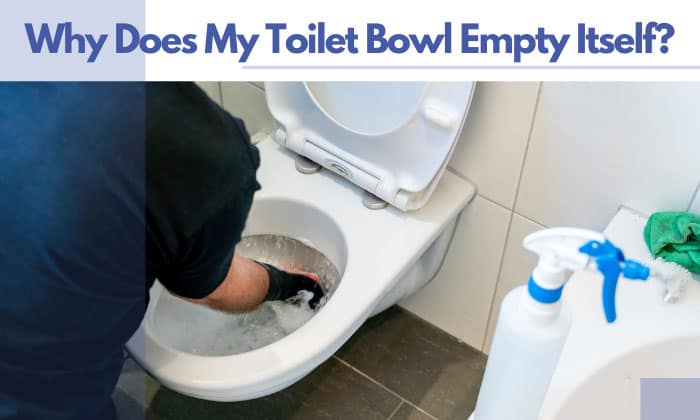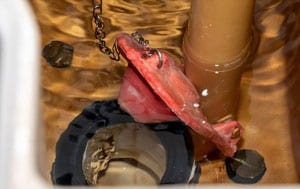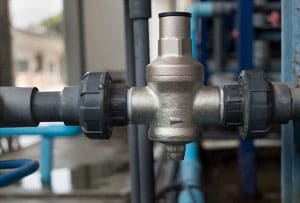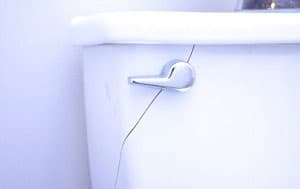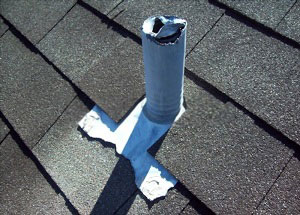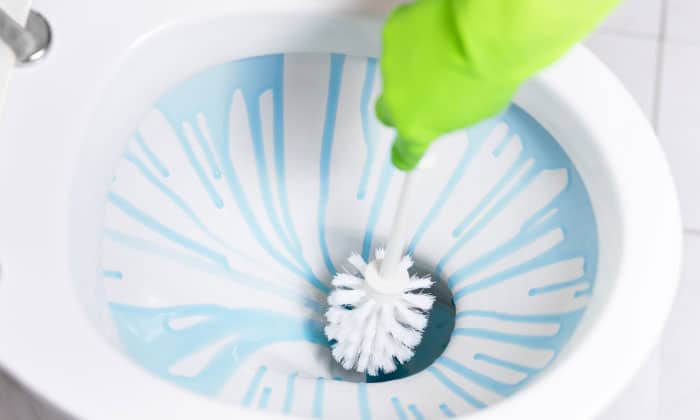You were sure that you didn’t push the flush but the toilet tank keeps draining. So why does my toilet bowl empty itself?
If your toilet drains on its own, there might be issues with the toilet flapper, high water pressure, toilet cracks, and a blocked sewer vent line.
In this article, we are going to explain each of these possible causes of the water not staying in the toilet bowl, and what you can do to fix it.
Table of Contents
Reasons for Toilet Bowl Emptying on Its Own
1. Toilet Flapper Issues
The toilet flapper is the plastic or rubber seal at the toilet tank’s bottom and above the flush valve’s seat that acts as a cover.
From the name itself, the flapper seals the tank along with the water inside it. When we press the flush, it opens—allowing the water to run down the bowl.
If the toilet slowly drains by itself and you see water continuously being released from the tank without initiating a flush, then the flapper might already be:
- Out of place
- Stuck in its chain
- Loose and worn out
If you need to adjust the flapper:
-
- The flapper must insert itself into the seat when the water level reaches a certain point (2 or 3 inches from the bottom of the tank).
- If you see that it does not fit perfectly into the seat, simply adjust it so it will do the latter. This might fix a toilet bowl losing water.
If the chain is stuck:
-
- The flapper has a chain that pulls it up and down. If it gets tangled, untwine the chain.
If the flapper is worn out:
-
- In this case, you need to replace the flapper. Start by turning off the shut-off valve and draining the water from the tank.
- Disconnect the flapper from the chain that connects it to the flush handle, remove it from the hinge, then remove it from the tank.
- Put your new flapper into the hinge at the tank’s bottom, connect the chain to the flush handle, and insert it into the seat.
- Test the flushing mechanism to see if the new flapper is properly installed and adjust it if necessary.
Solving toilet flapper issues can solve the water disappearing from the toilet bowl. If it didn’t, then continue reading the other possible causes.
2. High Water Pressure
This might sound new to you, but if you find your toilet tank empty without flushing or intentionally draining it, this might be because of your high water pressure.
This pressure can damage the fill valve—which is responsible for refilling the tank after a flush. If the fill valve gets faulty, it will not be able to open and close properly, resulting in a situation where the toilet bowl keeps draining.
If you also have pipes leaking or your water bill skyrocketed from regular, then this might be the problem. The solution is:
- Ask for help from a plumber to install or replace the pressure reduction valve (PRV) or the water pressure regulator.
3. Cracks in the Toilet
Ever wondered about a toilet bowl losing water but no leak in the bowl can be seen? Bad news; your toilet might have cracks.
A tank of a toilet bowl completely dry can be a result of the water leaking from the tank itself because of cracks. If this is the case, you can:
- Apply waterproof epoxy or porcelain sealer on the hairline crack(s) of the toilet and do it nicely so that water stops draining from the tank.
- But if the cracks are more than 1/16 inch wide, replacement is required, either the entire toilet or just the tank if it is designed as a two-piece.
4. Blocked Sewer Vent Line
If your toilet bowl drains completely—as in really dry—another possible cause is a blocked sewer vent line or plumbing vent.
Plumbing vents are those pipes on the roof of homes that allows air from your plumbing system to get out. This air is the pressure, and letting it out is important to let the water travel around the system when necessary.
If these vents are blocked, the plumbing system will not work the way it is supposed to. With that, the water will not come up to the toilet’s fill valve to be stored in the tank. Without pressure being let out, water cannot efficiently pass the pipes, thus creating issues such as water slowly draining from the toilet bowl.
With this problem, we highly recommend having a plumber unclog and clear your sewer vent line because doing so can be unsafe.
But if you want to see if you can handle it to save money as well, then follow these steps:
- Safely climb up to the roof with a stable ladder, cleaning gloves, and suitable shoes and clothing. Bring a plumber snake and a garden hose connected to a water supply.
- Clean the vent of whatever is not meant to be there: dirt, debris, and the like.
- Use the snake if the blockage is far from reach and deep down the system’s pipes.
- Finally, use the water from the garden hose to push the remaining clog.
Doing it yourself might work, but if it doesn’t, it is time to call a licensed plumber to do the job.
What Does It Mean When Your Toilet Bowl Is Dehydrated?
If the toilet bowl is empty but the tank is full, there may be a blockage in the toilet trap (S trap or P trap) because of toilet paper.
The toilet paper absorbs or siphons the water in the bowl; hence, removing this clog is using a toilet snake or auger. You can also try plunging, but the snake and auger may work better.
What If None of These Work?
Suppose you have tried all the ways above, but your toilet is still draining and flushing by itself, or the bowl is still dehydrated despite the water in the tank. In that case, contact a licensed plumber to ensure that it will be fixed professionally.
Conclusion
If you ever wondered, “Why does my toilet bowl empty itself?” there is a chance that your toilet tank has problems like the flapper. If you have high water pressure, this may also damage the toilet fill valve and cause continuous draining without flushing.
Other reasons might be the presence of cracks in your toilet and a blocked plumbing vent. If your tank has water, but your bowl is dry, then toilet paper is most likely clogging the trap.
With problems persisting after trying to address them yourself, calling a professional plumber is always the guaranteed solution.

I’m Paulk Webb, and I work as a writer for Saveourwaterrebates. I’m happy to put in the time and effort to conduct market research to identify the most pressing issues faced by households concerning their plumbing. Feel free to check out our guides to get the most informed recommendations for how to solve your problems.


